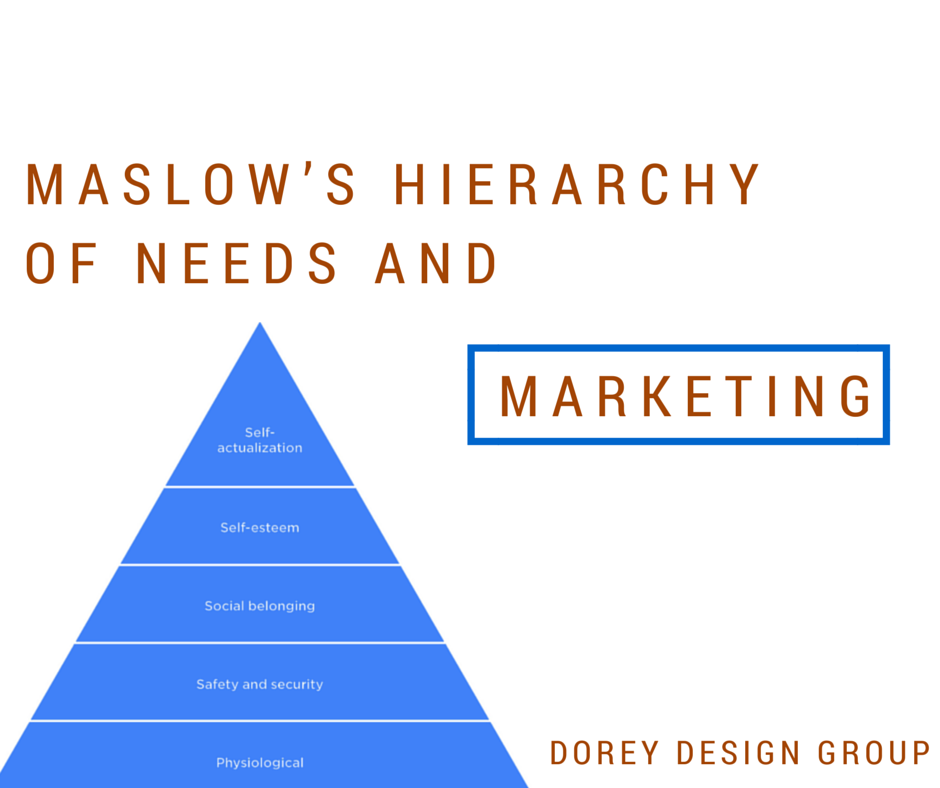Maslow’s Hierarchy of Needs and Marketing

Psychology and marketing often goes hand in hand. Early on in my studies, I would be asked by my primarily engineering major friends, “What is marketing anyway?” My response would always be something like, “It’s sort of like commercially applied psychology.” I stand by what I’ve said then; marketing communicates a product/service’s value with a customer, operating with an understanding of how people behave, interact, and think about things to most effectively deliver that message.
By applying theories of psychology, we can better understand consumer behavior and deliver more targeted and meaningful communications to our target audiences, and have a greater understanding of why we, as marketers, employ different marketing tactics to reach them. One of the most widely known theories that marketers know is Maslow’s Hierarchy of Needs. In this article, I’ll explain what that theory entails and how we can (and in some cases, already often are), apply this theory to our marketing practice.
► Website not looking or working right?
► Tell us about it.
The Hierarchy:
Abraham Maslow is the psychologist behind the theory, and published his paper “A Theory of Human Motivation” in 1943, which discusses psychological health and development of humans through a type of hierarchy, where when one psychological need is mastered, we can obtain the next level. His theory parallels other theories of developmental psychology, and this hierarchy continues to be a very widely used framework in sociology, psychology, management, and yes, marketing.
The hierarchy comprises of five levels of psychological needs, the first four of which he labeled ‘deficiency needs,’ meaning that if these needs are not met, an individual is likely to feel some degree of anxiety or tension. The five levels are Physiological Needs, Safety, Love/Belonging, Esteem, and finally, Self-Actualization. Because our brains are so complex, this hierarchy does not say that we can only obtain one need once the lower is satisfied, but instead, our psychological motivation is mainly concerned with obtaining one need more than the others. This means that if we have not mastered/obtained our physiological needs, that will be our primary motivation, but that we can also aim to satisfy higher levels at the same time. However, Maslow created the hierarchy as a way of representing different types of psychological needs and in which order he thought they should be met.
Physiological Needs:
Physiological needs are categorized as our most basic psychological motivation. It pertains to our survival needs and is our most basic motivation because if our physiological needs aren’t met, our bodies will ultimately fail and we will die. Air, food, and water, are the most important, with clothing and shelter to help shield us from various environmental hazards (extreme cold/heat) being second. Maslow has also said that maintaining an adequate birth rate is a survival instinct, so our sexual instinct would be located within this level as well.
As it pertains to marketing, it’s pretty basic. By appealing to a consumer’s primal needs, we encourage them to fulfill their basic psychological motivation. When a restaurant commercial advertises how filling their food is, or when an advertisement for living in Hawai’i is produced that showcases its naturally purified water system, these types of marketing communications seek to appeal to our psychological need to physically satisfy our survival needs.
Safety Needs:
Safety needs are the second level in the hierarchy, and contain the needs such as personal/financial security, health/well-being, as well as needing safety nets against accidents, illness, or breaches in security. This need arises after physiological needs have been satisfied, and explains individuals whose primary motivations are things like job security, insurance, and obtaining wealth. Lack of economic security especially enhances preference for job security over the job description itself, and the lack in health and well-being of an individual can result in psychological problems like trauma/increased stress. Fulfilling these needs makes us feel assured that even if bad things happen to our well-being/economic health, we’ll still be fine.
When you see insurance commercials that depict a customer in an accident, or health companies advocating immunizations, they are appealing to your safety motivations. Another example would be a commercial featuring the safety ratings of a new car being release, prioritizing that value of the product over price, tech, luxury, etc. The fear of not being able to recover from an illness or economic damage (getting into a car accident), is a very popular marketing communications technique to assure the customer that the company will protect them from such dangers. I do see fear being used to appeal to safety needs very commonly, and this theory explains why we as humans respond so well to these messages.
Love/Belonging:
This motivational plateau refers to our interpersonal relationships and the health of those relationships. Humans are social beings, and we need to have a sense of belonging among social groups, no matter how big or small. The need to love and be loved arises as a predominant motivation after the first two needs have been mastered.
To go on a tangent, I’ve mentioned mastered a couple times before now, and this refers to not only meeting the psychological need, but having control over it. This means at this that at this level, you have ready access to all the physical needs you require to survive, and that you’re not living paycheck to paycheck plus acquiring additional debt from all of your insurance/loan payments you have to make.
The love and belonging need of humans deals with family, intimacy, and friendships and the strength of those relationships. It’s interesting to note that this level can overcome physiological and safety needs depending on pressures and stresses caused by these relationships. Depression that occurs due to unhealthy relationships can cause a lack in eating habits for example.
We see the need to belong most in social media. Social media is inherently interpersonal in its very use, as well as an important function of marketing communications. Why is this?
This is because as a company, we seek to build brand communities that allow our customers to feel like they belong to something. Creating a feeling of belonging with our customers satisfies the love and belonging psychological need. Since it is the third level, it’s also especially powerful. Our strongest brand advocates are often time other customers that feel like part of their social identity is tied in with our brand (known as word of mouth marketing). Creating a great brand community (Examples of brands with strong communities on and offline: Harley Davidson, Starbucks, Apple) creates great engagement and interest in everything your company does because it helps to satisfy an individuals need to belong.
Esteem:
Maslow defined the Esteem level as a need for status, recognition, strength, attention, or mastery/competence of something. In order to master this psychological need, an individual has to accept who they are internally, which relates a lot to the final psychological need (we’ll get there). You’ve all heard of having a great self-esteem/sense of self-respect, and this is what that need pertains to. Failure to achieve an adequate level of esteem can lead to an inferiority complex or other weakness, and things like depression can negatively affect your esteem. People’s professions and hobbies often reflect this need to gain recognition.
Because humans have a need to feel respected, marketers can often appeal to this higher level of psychological motivation as a way to persuade customers. By offering a luxury experience, an opportunity to master something, or gain recognition, companies can often influence a customer’s buying decisions in appealing to their esteem. For example, with luxury cars and watches, they appeal to esteem by positioning themselves as a symbol of a person’s status, and something that people of a high status use/have. Additionally, software programs that teach you skills like the Khan Academy and Lynda.com offer you an opportunity to gain competency/mastery in a wide variety of skills and subjects, which increases your esteem.
This is the last level of deficiency needs, meaning that if a human satisfies all four of these needs, meaning that once all of these needs are met and mastered, an individual will feel content with their life. But not all individuals stop there. The highest level deals with the primary motivation of ‘exemplary people,’ as Maslow put it. Those who strive to succeed, set pace, and trail blaze their mark on human civilization.
Self-Actualization:
“What a man can be, he must be.” ~Abraham Maslow
The top psychological need of the hierarchy is one that’s not ‘required’ for full psychological development, but is required to be a ‘fully-realized’ individual, to put it simply. Self-Actualization deals with the realization and obtainment of an individual’s full potential, a meaning which is subjective and defined by the individual themselves. It manifests as a desire to accomplish everything that he/she can be and ‘make the most out of their life.’ Some examples of this motivation could be to become the best musician who ever lived, be the best athlete of their sport, or simply to become the best possible parent they can be. Whatever it is, it is the ultimate achievement in that person’s eyes.
This is the hardest need as marketers to appeal to because as a company, there’s a great chance that the products/services that we sell don’t comprise a whole person’s identity (Their life is not built around owning a Nike Hyperdunk 2.0). What we can do to appeal to this level of motivation is be a brand that represents achieving self-actualization and one that helps and individual get there. To re-use the Nike example, a lot of their marketing communications help inspire their customers achieve physical self-actualization. Their slogan is “Just Do It,” as a motivational statement to help users get through the physical pain of training that’s required to achieve results in their activities. In a commercial promoting their brand (notice, they promote the brand, not the product), Nike uses a song by The Hours called, ‘Ali in the Jungle,’ in which the main line repeated is:
“It's, not how you start, it’s how you finish.
And it's, not where you're from, it's where you're going now.
Everybody gets knocked down,
How quick are you gonna get up?”
Nike embraces their role in helping an individual accomplish self-actualization by becoming a source for inspiration, and this method of connecting with their audience is part of the reason why Nike is so successful in advertising.
Closing Thoughts:
There’s a lot more examples we can look at in the advertising/marketing world, but the bottom line is that by appealing to some level of Maslow’s Hierarchy of Needs, companies communicate their messages effectively to their target audience. I see the hierarchy as the ‘why it works’ behind all of our marketing communications, and I believe being aware of that fact is important to consistently communicating value to customers. By aligning the message with a customer’s psychological needs/motivations, we can focus content and provide more relevant and useful information, products, and services. That to me, is great marketing.
We know a lot about marketing. DDG builds beautiful websites that express your branding message correctly. Need your business/brand to be found by an online target audience? Let's talk.
Read more from our blog:
9 Creative Ideas for Brand Marketing with Snapchat in 2016
How to Optimize a Facebook Event for Success
Brand Image Responsibility and Viral Marketing: The Heineken Case
Golden Ratio in Web Design: Creating a Divine Website
